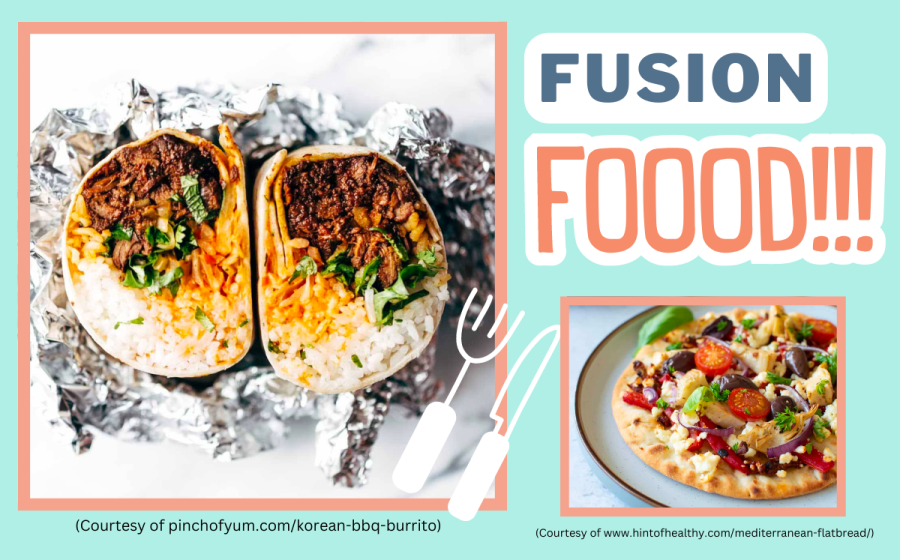AJ’s beef (literally) with fusion food
AJ shares her “beef” with fusion food.
Visiting Los Angeles, you see a lot of trendy restaurants serving “fusion” food. I went to a restaurant whose name I won’t throw under the bus and ate a pork bulgogi burrito that I thoroughly enjoyed. Yet, it somehow bothered me and I couldn’t describe why. Eventually, I concluded that I have two qualms with fusion food overall.
The thing is, there are tons of starch bases around the world used by different nations. Different types of bread, noodles, pasta, doughs, grains, and corn mixtures provide different vessels or bases for a variety of flavors. But that’s exactly why they are used—you can pair them with a wide range of things. There are almost endless meats, stews, and sauces you can have with penne, rice, or injera. A bunch of things you can put in arepas or bao buns or eat with naan. The point of these staple foods is their versatility.
Yet, here we find ourselves using the same flavor and meat vessels over and over again in our fusion food. See for yourselves! You look up “fusion burrito” and up comes poki burritos, Vietnamese burritos, lamb curry burritos, orange chicken burritos, ramen burritos, and even Yorkshire pudding burritos (that sounds absolutely disgusting). Similarly, you can easily find recipes and options for tandoori pizza, tom yum Thai pizza, Asian sriracha shrimp flatbread, and chorizo manchego flatbread.
Among the plethora of food carriers previously mentioned, there’s a tendency to pinpoint those staple foods in which American palettes are already accustomed, dump whatever culturally different flavors you want, and go trending for your “fusion food.” I understand the strategy of meshing the known with the new to provide something Americans are comfortable with while pushing them to expand their horizons. However, I think some of us are ready for more than burritos.
Just think, for every American who pronounces Tajín as “Tajeen,” there’s another California hipster who’s burning to tell their friends about fusion food that involves the most niche, authentic flavors to improve their standings as a culturally competent individual.
My second issue is, as I mentioned, the combination of a food vessel with a food vessel from another culture is cool, but doesn’t feel revolutionary. As I said, certain staple foods are intended to be used with many, many things, and to place it with another flavor would, well…do exactly what that food was intended to do. Putting together distinct ingredients and spices that represent completely different flavor profiles to create something both enticing and slightly terrifying to try—well that’s innovation. However, Thai clam chowder is the only decent example of this I could find. I genuinely don’t know whether these innovative dishes will be mind-blowing or abhorrent, but those are the kind of stakes I expect from my fusion food.
Ultimately, the revolutionary vs unrevolutionary labels I place on fusion food don’t signify much. As Natasha Geileng stated in her article, “the blending of culinary worlds to create new, hybrid dishes, has been around since the beginning of trade; so vast is its history that it’s almost impossible to discern the ‘original’ iteration of fusion food.”
Coincidentally, she references the Korean taco as an example of a dish that’s been wrongfully labeled “revolutionary,” which was the same cultural flavor combination that fired me up about this topic in the first place. Geileng describes how certain traditional national foods are themselves “fusion” food. The Jamaican patty was influenced by the English turnover, East Indian spices, and African flavors. The Vietnamese street food bánh mì has heavy French influence with its use of pâté, mayonnaise, and baguette. Even Indian chutney has global variations, thanks to the British adopting and spreading chutney to its vast territories.
All this to say, fusion food is far from new. Consider the influences of colonization and international trading of ingredients and spices on what we consider cuisine today. In some places with strong intersections of cultures from various continents such as Brazil, the Caribbean, and the Philippines, “fusion” could be used to describe the entire cuisine of the nation. No hate to those trendy fusion restaurants (well, maybe a little hate), but the mix of ingredients and flavors and transformation of traditional dishes has always existed as a reflection of the blend of cultures in our society as a whole.
With that said, if someone offered me a Korean burrito or taco, I’d probably still eat it.
Your donation will support the student journalists of Watkins Mill High School. Your contribution will allow us to purchase equipment and cover our annual website hosting costs.

Andrea “AJ” Gordon is a senior at Watkins Mill High School and Opinion Managing Editor for The Current. She is an IB Diploma student and is a part...









